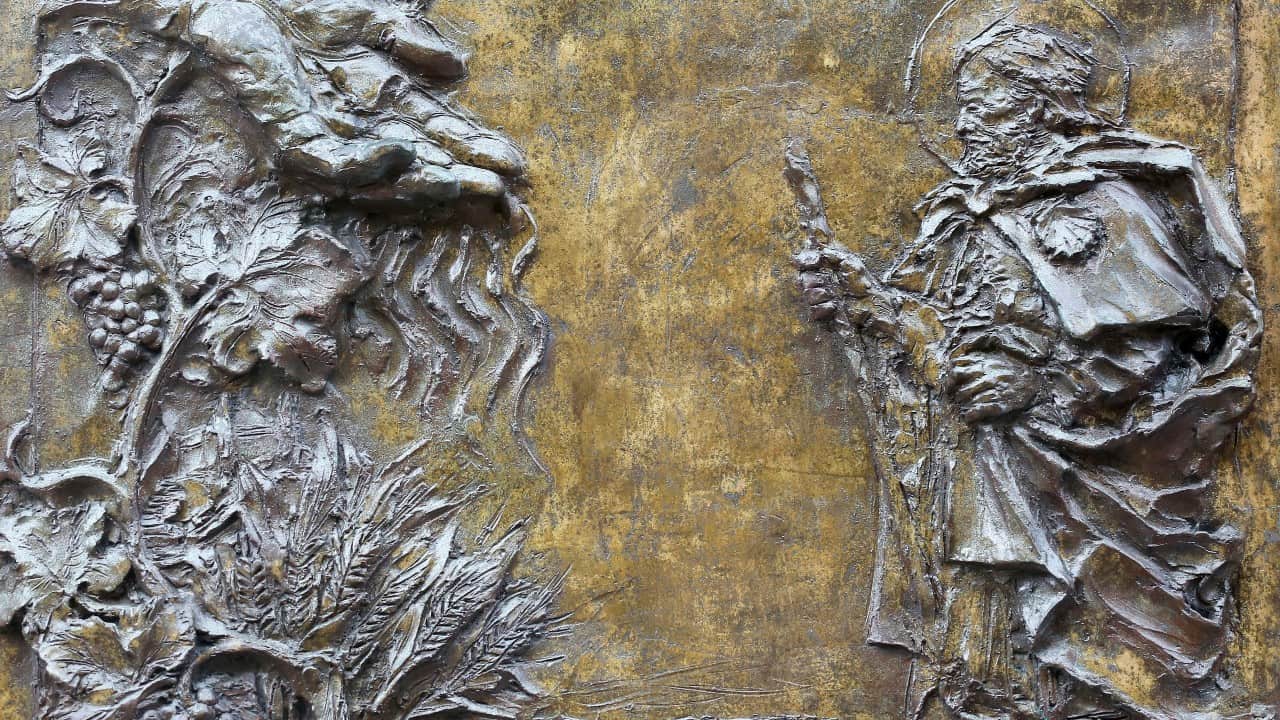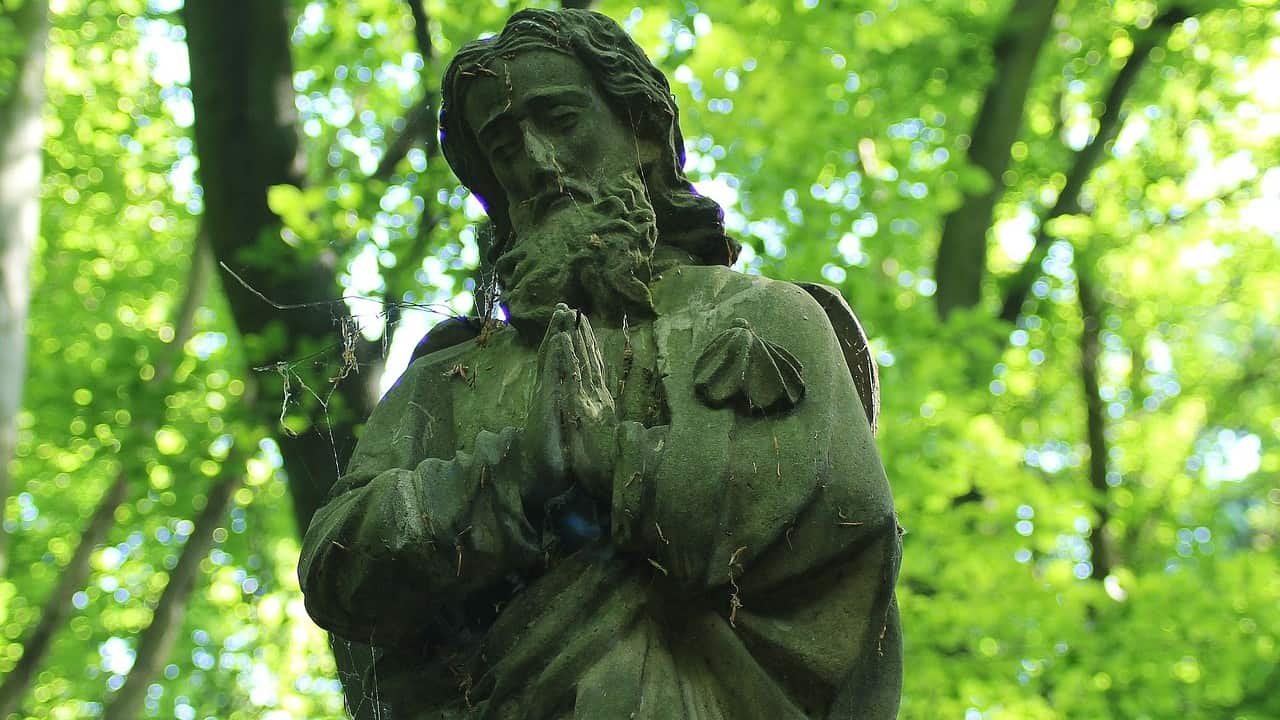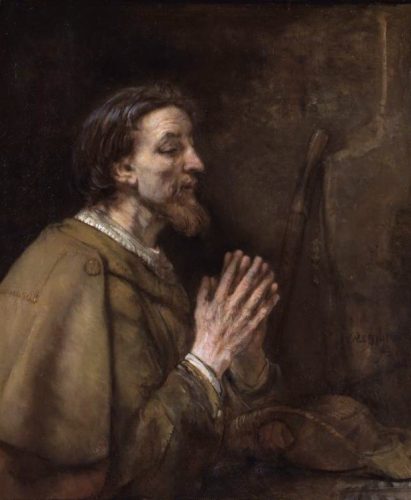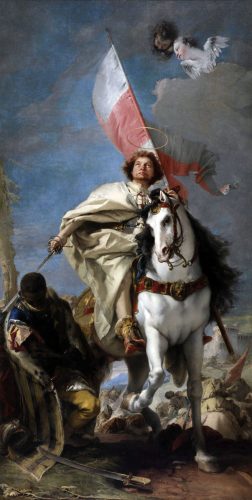St James the Great was one of the Twelve Apostles of Jesus Christ. Also called James the Elder, he was the first apostle to become a martyr and the only one whose martyrdom was recorded in the New Testament. Son of Zebedee and Salome and brother of John the Apostle, Saint James the Great is the Patron of Pilgrims and Laborers. He is also known as the Patron Saint of Spain, having earned the Spanish title Santiago Matamoros which means “Saint James the Moor-slayer”. As you may expect Saint James is also the Patron Saint of Pilgrims. See here for more on the history of the Camino de Santiago.
Early Life
Not much is known about the early life of Saint James the Greater. He was probably born somewhere in Bethsaida or Capernaum, where his father Zebedee lived. His parents appear to have had good social standing. Zebedee was a fisherman at the Sea of Galilee located south of Capernaum, and had a few boatmen and hired men as servants. Salome, the wife of Zebedee and mother of James the Great, was thought by Zahn to have been the daughter of a priest.
James was one of two sons, and was likely to be the elder of the two. With the exceptions of select passages (Lk 8:51, 9:28; Acts 1:13), Apostle James was always mentioned before John, which suggests that he was the older brother. It is possible that James did not acquire technical training at rabbinical schools like his brother (Acts 4:13). As such, the Jews must have considered them unlearned and having no official standing in their society. Their parents’ social ranking suggests otherwise, and they must have received some education in standard Jewish practices. Despite having unclear education, James had plenty of opportunities to be exposed to Greek life and language, which flourished along the shores of the Sea of Galilee.
Discipleship and Apostolate
James was one of the first disciples of Jesus, though there are varying accounts of how he came to be one. In the gospel of John, after John the Baptist had proclaimed the kingdom of Jesus, John became a disciple and afterwards brought his brother James to Jesus (Jn 1:35, 1:41). In the gospels of Matthew and Mark, the discipleship of Apostle James is described in greater detail. Here, James is seen fishing on the Sea of Galilee with his brother and father when Jesus called out to them from the shores (Matt 4:21-22; Mk 1:19-20). The fisherman were unable to catch fish that day, and Jesus asked them to dip their nets once more into the waters. Following his instruction, they found their nets full of fish that their boats almost sank from the weight as soon as they emptied their nets on board. James and John left their nets and father to follow Jesus and become “fishers of men”.
St James the Greater was also among the few to witness Jesus’ miracles. Together with his brother John and the disciples Peter and Andrew, they formed the first chosen group of disciples (Jn 1:41) before being called into Apostleship with eight more (Matt 10:1-4; Mk 3:13-19; Lk 6:12-16; Acts 1:13). James, John, and Peter were present during the raising of Jairus’s daughter (Mk 5:37; Lk 8:51), the Transfiguration of Christ (Mk 9:1; Matt 17:1; Lk 9:28), and Jesus’ Agony in the Garden of Gethsemane (Matt 26:37; Mk 14:33), indicating their close relationship with Jesus.
There is reason to believe that Jesus had familial ties with James and John. A comparison of the Synoptic gospels suggest that Mary, mother of Jesus, was a sister of Salome, mother of James (Jn 19:25; Matt 27:56; Mk 15:40). This would make Jesus a first cousin of the brothers, and might explain why they became his first disciples.
Titles
Saint James the Greater
Saint James, son of Zebedee was called “the Greater” or “the Great” to distinguish him from Saint James “the Lesser” or “the Less,” a son of Alpheus who was believed to have been younger or shorter in stature, as well as James the Just, brother of Jesus.
Saint James, the Boanerges
Jesus ascribed the Greek title Boanerges or “Sons of Thunder” to James and John (Mk 3:17). Several events in the Synoptic Gospels reveal their fiery and impetuous attitude towards evangelism, as well as a severe temper (Lk 9:49, 9:54). The occurrences suggest that the brothers embodied the character of the title given to them. Perhaps this could be explained by their racial heritage, as Galileans were known for being hardy, religious, brave, industrious, and the strongest defenders of the Jews.
Santiago Matamoros (Saint James the Moor-Slayer)
During the Battle of Clavijo, it is said that Saint James the Great miraculously appeared to provide assistance to an outnumbered Spanish Christian army, helping them gain victory against the Moors who had started their conquest of Hispania in AD 711. The battle is placed between AD 834 and 844, about 800 years after the death of St James the Greater. According to legend, Saint James, appeared as a warrior on a white horse amidst the Spanish army, wielding a white banner. Upon seeing him, the Christian army cried out “¡Dios ayuda a Santiago!” which translates to “God save St. James!” It is believed that more than 5,000 Moors were killed during the battle, earning St James the title Matamoros or “Moor-slayer”.
Many historians argue that the Battle of Clavijo never took place and that it was a myth based on the historical Battle of Monte Laturce (AD 859). The legend only appeared in writing nearly 300 years after its alleged occurrence. However, the historian Jean Mitchell-Lanham adds that while it was based on legend, the battle provided Spain with “one of the strongest ideological icons” and helped establish its national identity.
Martyrdom
St James continued to preach for 14 years following the death of Jesus in AD 30. He preached in Samaria and Judea, where he met his death under King Herod Agrippa I. Herod was known for his zeal in Judaism, having shown high regard for the Mosaic Law and Jewish customs. During his reign as king of Judea, the Jews felt threatened by the rapid growth of the Church.
In response, Herod had members of the Church arrested on the Passover of AD 44, and ordered the beheading of James the Great (Acts 12:1-2) for his role in Jewish-Christian communities, and whose zealous temper must have left an impression on him. St James the Greater is the only apostle whose martyrdom was recorded in the New Testament, making him the first of the Twelve of Apostles to be martyred for his faith.
St James the Patron Saint of Spain
In some traditions, it is believed that Saint James preached Christianity in Spain prior to his death and that James founded an Apostolic see on the peninsula. The origin of these legends can be traced from Compostela and are described briefly in the 12th century Historia Compostelana commissioned by Bishop Diego Gelmirez. Here, it is said that James preached the gospel in Iberia as well as in Israel, and that following his martyrdom, his disciples brought his body across the sea to Iberia before being taken to Santiago de Compostela where it was buried.
Ancient lore dictates that while in Spain, the Blessed Virgin Mary had appeared to Saint James on 2 January AD 40 on a pillar along the banks of the Ebro River at Caesaraugusta. This apparition later came to be known as Nuestra Señora del Pilar or “Our Lady of the Pillar.” The translation of his relics from Judea to Iberia, as other legends puts it, involved a series of miraculous events; that after being decapitated by Herod Agrippa, his body was carried off by angels and sailed in an unattended boat, which, upon arrival on Iria Flavia, became enclosed in a massive rock. His remains were believed to have been discovered during the tenure of King Alfonso II (AD 791-842) and Bishop Theodemir of Iria.
The existence of these legends led to the establishment of a pilgrimage route in the 9th century known as Camino de Santiago or “The Way of Saint James”. It consists of several routes spread throughout Western Europe and culminating at Santiago de Compostela where a shrine dedicated to the saint is located. The popularity of the pilgrimage site, along with his legendary appearance in the Battle of Clavijo, prompted St James the Greater to be officially recognized as the Patron Saint of Spain.
Controversy
Traditions of the early Church contradict the legends in Compostela. According to Clement of Alexandria (Stromateis) and Apollonius (Ecclesiastical History VI.18, Eusubius), St James the Greater never left Jerusalem until the time of his martyrdom in AD 44. In his Epistles to the Romans (AD 58), Saint Paul expressed that he did not want to “build on another man’s foundation” and that he intended to visit Spain (Rom 15:20, 15:24), which suggests that no other evangelist had been there at the time of its writing. The Catholic Encyclopedia (1908) cited “difficulties” with respect to the bases of these legends, particularly their late appearance in the ninth century and their absence in the works of early writers.
The authenticity of the sacred relic in Compostela has also been questioned, especially after the Church of St-Saturnin in Toulouse, France, claimed to have the relics of Saint James the Great. Although relics were probably divided between the two churches, there is also the possibility that only one of them or none proved to be true. Notker of St. Gall believes the relics may have been brought to Compostela as legends describe it, though he remains doubtful that the saint reached as far as Spain when he was still alive. The Bull of Leo XIII, Omnipotens Deus of 1 November 1884 asserts the relic’s authenticity in Compostela.
Saint James the Patron Saint of Pilgrims and Laborers

James the Great is regarded as the Patron Saint of Pilgrims and Laborers, not for Santiago de Compostela, but for his pilgrimage to Judea, where he was beheaded in AD 44. The pilgrimage took place after he proselyted the Christian religion in the Hispanic territory. Saint James is attributed to the pilgrim’s hat and scallop shells which are abundant along the shores of Palestine. Pilgrims to the Holy Land can be seen wearing hats adorned with scallop shells, as a display of their pious intentions.
When is the Feast Day of Saint James
There are variations of St James’ feast day based on geography. Western Christianity celebrates it on July 25, Eastern Christianity on April 30, and the Hispanic Church on December 30.

I love hiking, backpacking, and camping. From the Camino de Santiago to the West Highland Way in Scotland or simply a great day hike on the weekend. Hiking refreshes me, my mind, and keeps my body reasonably fit. So far I have walked three Camino routes and many other long distance hikes in the UK, Canada, and around the rest of Europe. One of the best was my hike up Ben Nevis.



